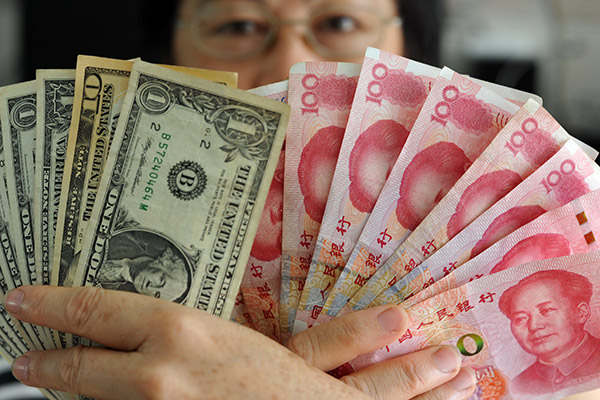New formula seen helping yuan to rise or stay stable
 |
|
A forex trader in Hainan's Qionghai displays renminbi and US dollars. The Chinese currency might continue to rise, defying predictions of a downtrend. [Photo/China Daily] |
Economic resilience, Fed hike expectation, liquidity emerge as key factors that could move the currency
Encouraged by the resilient economy and the new yuan-dollar pricing formula, the Chinese currency might continue to rise, or remain stable, against the US dollar in the short-to medium-term, market analysts said.In just five trading days before and after the May 28-30 Dragon Boat Festival holiday, the yuan unexpectedly rose more than 1 percent against the dollar in the offshore as well as onshore currency markets.
On the first trading day of this year (Jan 2), the dollar-yuan rate was 1:6.94. On May 29, the yuan closed at 6.87 to a dollar, rising to 6.80 by June 1.On Friday, it closed at 6.79, confirming an overall 2.2 percent rise this year so far.
The market, however, had predicted that the Chinese currency might experience a new round of downward fluctuations as risks from a weakening US dollar were fully unleashed.
People's Daily quoted Zhang Huanbo, deputy researcher at the China Center for International Economic Exchanges, as saying that the Chinese economy has stabilized and improved since the second half of last year.
Many companies, Zhang told the daily, reported that demand for consumer goods at home and abroad has rebounded this year. "This has no doubt laid the foundation for continued strength in the yuan."
Hu Yuexiao, chief macroeconomy analyst of Shanghai Securities, wrote in a research note, "As the global economic situation has entered a new stage, the foundation for the promotion of the RMB's foreign value has been steadily strengthened."
Under the framework of the yuan's globalization and the Belt and Road Initiative, the best choice is to maintain a steadily growing exchange rate,Hu wrote.
The opening-up of China's capital market has never stopped, and there are no signs that China's economic growth will further slow due to tighter global liquidity, she said.
"In terms of economic fundamentals, although China's GDP growth has slowed since 2012, it's still in the top tier among the world's major economies," she said.
China's GDP grew by 7.8 percent to 51.9 trillion yuan ($7.63 trillion) in 2011, and by 6.7 percent to 74.4 trillion yuan last year.
"The steady advance of reform policies, such as supply-side reform, will enable the Chinese economy to open up a huge area for transformation and upgrading," she said.
In addition, contrary to predictions, China's financial liberalization has been moving forward methodically, she said.
The China Foreign Exchange Trade System, a public institution under China's central bank, said on May 26 that the country was considering a change in formula for the yuan-dollar central parity rate to curb volatility.
With the "counter cyclical factor," the new formula will be able to hedge against fluctuations in market sentiment and alleviate the herd behavior of investors, the CFETS said.
Under China's market-based, managed floating exchange rate system, on each trading day, the yuan can rise or fall by 2 percent against the dollar from the central parity rate.
The central parity rate is a weighted average of quotes from dealer banks, and follows a formula based on the previous day's closing rate and changes in a basket of select currencies.
The move, as part of a broader effort to ensure market stability, had prevented the yuan's depreciation in the short term, said Tan Han, an analyst at Guotai Jun'an Securities.
Some industry insiders now believe the yuan will remain stable.
Bloomberg quoted Neeraj Seth, the Singapore-based head of Asian credit at Black-Rock Inc, the world's largest money manager, as saying that China is important to Asian growth from a currency market standpoint. The yuan's bounce "further strengthens the view that we are in a more stable Asian currency regime right now".
Seth sees more stability in the yuan in the medium term. "Not necessarily a one-way path of appreciation, but more of keeping the currency stable, which obviously provides a very supportive backdrop," he told Bloomberg.




















